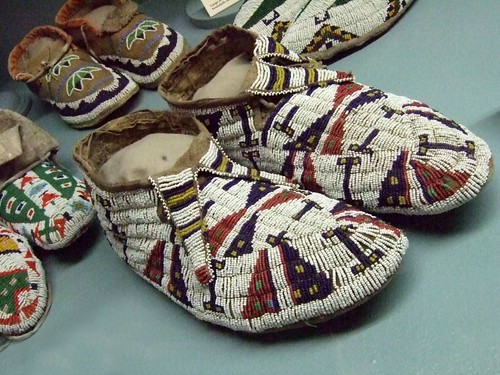FEATHER HEADDRESS
referred to as the 'war bonnet'
Feathered war bonnets (also called warbonnets or headdresses) were worn by honored Plains Indian men, sometimes into battle, but most often for ceremonial occasions, and were seen as items of great spiritual and magical importance.[1][2] The eagle was considered by Plains tribes as the greatest and most powerful of all birds, and thus the finest bonnets were made out of its feathers.
Someone holding a completed bonnet could tell countless stories. The bonnet was only worn on special occasions and was highly symbolic. Its beauty was considered of secondary importance; the bonnet's real value was in its supposed power to protect the wearer.
The bonnet had to be earned through brave deeds in battle because the feathers signified the deeds themselves. Some warriors might have obtained only two or three honor feathers in their whole lifetime, so difficult were they to earn. The bonnet was also a mark of highest respect because it could never be worn without the consent of the leaders of the tribe. A high honor, for example, was received by the warrior who was the first to touch an enemy fallen in battle, for this meant the warrior was at the very front of fighting. Feathers were notched and decorated to designate an event and told individual stories such as killing, capturing an enemy's weapon and shield, and whether the deed had been done on horseback or foot.
After about ten honors had been won, the warrior went out to secure the eagle feathers with which to make his bonnet. In some tribes these had to be purchased from an individual given special permission to hunt the bird; a tail of twelve perfect feathers could bring the seller as much as a good horse. Some tribes permitted a warrior to hunt his own eagles. This was a dangerous and time-consuming mission and meant that he had to leave the tribe and travel to the high country where the bird could be found. When the destination had been reached, ceremonies were conducted to appeal to the spirits of the birds to be killed.
A chief's war bonnet is made of feathers received for good deeds to his community and is worn in high honor. Each feather would represent a good deed. A warrior's war bonnet, such as the famous war bonnet of Roman Nose, the Cheyenne warrior, served to protect him during battle. In several instances Roman Nose, wearing his war bonnet, rode back and forth before soldiers of the United States Army during battles of theIndian Wars and despite being firing upon by many soldiers was unscathed.[2]
Chiefs and honored warriors still sometimes wear war bonnets for ceremonial occasions.
Source // Wikipedia
Source // SmileyMe
Source // WeHeartIt
Source // TLW
Source // OldPicture
BUCKSKINS
Buckskins are clothing, usually consisting of a jacket and leggings, made from buckskin, a soft sueded leather from the hide of deer or elk. Buckskins are often trimmed with a fringe — originally a functional detail, to allow the garment to dry faster when it was soaking wet because the fringe acted as a series of wicks to disperse the water — or quills. [1]
Buckskins derive from deerskin clothing worn by Native Americans. They were popular with mountain men and other frontiersmen for their warmth and durability. Buckskin jackets, often dyed and elaborately detailed, are a staple of western wear and were a brief fad in the 1970s.
Source // Wikipedia
Source // HMNS
Source // SWS
Source // PrariEdge
A Moccasin is a form of shoe worn by Native Americans, as well as by hunters, traders, and settlers in the frontier regions of North America
Traditional Native American clothing varied widely from tribe to tribe, but one nearly universal element was the moccasin, a sturdy slipper-shaped type of shoe sewn from tanned leather. The word "moccasin" comes from an Algonquian word (also spelled mocasin, mocassin, moccassin, or mocussin, depending on the language and transcriber), but that is only because Algonquians were the first Indians encountered by Europeans--they were used as footwear from Sonora to Saskatchewan, and though "moccasins" may be understood and accepted by all of them at this point, most Indian tribes have their own native word for them.
All American Indian moccasins were originally made of soft leather stitched together with sinew. Though the basic construction of Native American moccasins was similar throughout North America, moccasin patterns were subtly different in nearly every tribe, and Indian people could often tell each other's tribal affiliation simply from the design of their shoes. (In fact, the common names of some large nations like the Blackfoot and the Chippewas refer to their characteristic moccasin styles.) Tribal differences included not only the cut of the moccasins (here is an excellent map of North America showing moccasin designs among different tribes), but also the extensive beadwork, quillwork, and painted designs many Indian people lavished on their shoes. In some tribes hardened rawhide was used for the sole for added durability, and in others rabbit fur (or, later, sheepskin) was used to line the leather moccasins for added warmth. Plains Indian women also woremoccasin boots sometimes, which were basically just women's thigh-length leggings sewn to their moccasins for a one-piece look (very beautiful when fully quilled). Heavier-duty boots calledmukluks were the invention of the Inuit (Eskimos), who made them of sealskin, fur, and reindeer hide; some subarctic Indian tribes adapted the mukluk style through trade or other contact with the Inuit, using caribou or buckskin instead.
Source // native-lanuguages
Source // ConverseClocks
Source // Farm1











Leave your comment